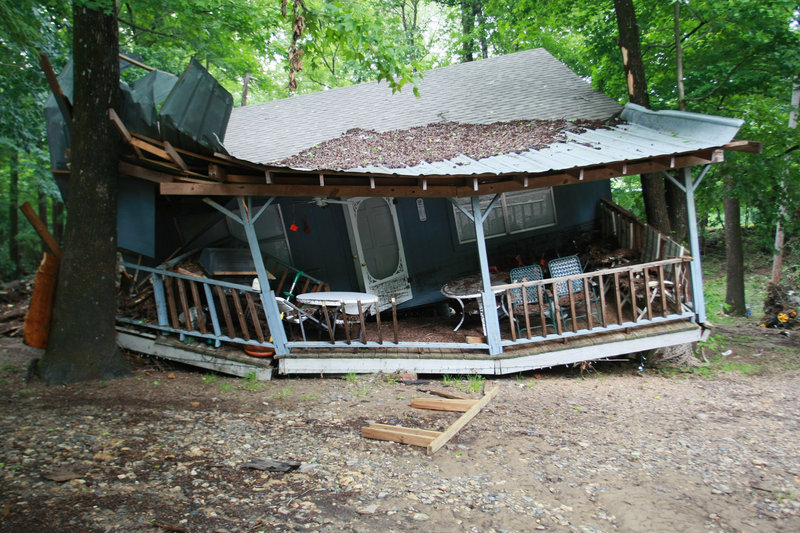CADDO GAP, Ark. — Rescue crews took to kayaks, horseback and ATVs at daybreak today to resume the desperate search for dozens of campers still missing after flash floods swept through a popular campground, killing at least 17 people.
The pre-dawn Friday surge along the Caddo and Little Missouri rivers caught sleeping campers in and around the Albert Pike Recreation Area by surprise, leaving them little time to try to scramble in the darkness to higher ground and safety.
Authorities don’t know how many people are missing, and a registry those using the campground are required to sign was washed away in the floods. But by Friday night, a call center set up for people to report loved ones who went missing in the area fielded 73 calls.
The search was expected to take several more days, and perhaps even weeks, and anguished family members of the missing who gathered at a nearby church could only wait helplessly for word of their loved ones.
“It’s like a nightmare that someone’s wanting to wake up from, but you can’t,” said Maj. Harvey Johnson, with the Salvation Army. “It’s the deer caught in the headlights look.”
Cell phone service and visibility from the air in the heavily wooded area are very poor, hampering search efforts. Crews on horseback and ATV returned to the craggy Ouachita mountains to look for possible survivors, as searchers in kayaks and canoes explored the tangled brush along the river banks for bodies and debris.
Portable cell towers were dispatched to the area in the hopes that stranded survivors could get reception and call for help.
Floodwaters rose as swiftly as 8 feet per hour, poring through the remote valley with such force that it peeled asphalt from roads and bark off trees. Cabins dotting the river banks were severely damaged. Mobile homes lay on their sides. Some described the quick rise of the water as a tsunami in a valley.
Tabitha Clarke, a National Weather Service hydrologist in Little Rock, said today the wall of water that swept through the campground could have been worse than the 23.4 feet reported Friday because the valley in the area it’s in is so narrow. The nearest river gauge was 4.5 miles downstream. A gauge there showed a 20½-foot rise in a four-hour period early Friday.
“It would have been even worse where they were,” Clarke said, although she declined to estimate how much higher the water could have been. At the campground today, debris hung in trees at least 25 feet above the river’s surface.
Authorities prepared for a long effort and said bodies may have been washed away. It would be difficult for someone to signal for help because of the rugged and remote nature of the area being searched, some 75 miles west of Little Rock.
“This is not a one- or two-day thing,” said Gary Fox, a retired emergency medical technician who was helping identify the dead and compile lists of those who were unaccounted for. “This is going to be a week or two- or three-week recovery.”
Brigette Williams, spokeswoman for the American Red Cross in Little Rock, estimated that up to 300 people were in the area when the floods swept through.
Forecasters had warned of the approaching danger in the area during the night, but campers could easily have missed those advisories because the area is isolated.
Denise Gaines said she was startled awake in her riverfront cabin by a noise that sounded like fluttering wings. She saw water rushing under the cabin door.
“I thought it must have been an angel that woke me up,” she said. She woke up the six others in her cabin and started packing her things.
Gaines, who lives in Baton Rouge, La., had been through violent weather before with Hurricane Gustav.
“We could feel the cabin shaking,” said her fiance, Adam Fontenot.
After the cabin filled with chest-deep water, the group clung to a tree and each other outside for more than an hour. Then the water dropped quickly, several feet in just a few minutes.
As the water receded, the devastation emerged: Vehicles were piled atop each other, and bodies were in the water. The group sought shelter in a nearby cabin higher off the ground. They were eventually rescued in a Jeep.
Wanda McRae Nooner, whose son and daughter-in-law have a home and a cabin along the river, said her son was helping rescuers.
“I know they’ve been bringing the bodies up there in front of their house until they can get ambulances in and out. It’s just the most horrible thing. It’s almost unbelievable.”
State police have identified 14 of the 17 bodies recovered, but did not disclose names of the dead, which included a number of children.
The rough terrain likely kept some campers from reaching safety, according to Tabitha Clarke, a hydrologist with the National Weather Service office in North Little Rock.
Some parts of the valley are so steep and craggy that the only way out is to hike downstream. Any hikers who had taken cars to the campsites would have been blocked at low-water bridge crossings that are inundated when the rivers rise, she said.
Send questions/comments to the editors.



Success. Please wait for the page to reload. If the page does not reload within 5 seconds, please refresh the page.
Enter your email and password to access comments.
Hi, to comment on stories you must . This profile is in addition to your subscription and website login.
Already have a commenting profile? .
Invalid username/password.
Please check your email to confirm and complete your registration.
Only subscribers are eligible to post comments. Please subscribe or login first for digital access. Here’s why.
Use the form below to reset your password. When you've submitted your account email, we will send an email with a reset code.